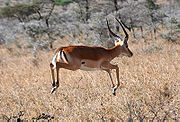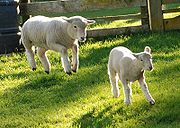
Stotting
Encyclopedia

Gait analysis
Gait analysis is the systematic study of animal locomotion, more specific as a study of human motion, using the eye and the brain of observers, augmented by instrumentation for measuring body movements, body mechanics, and the activity of the muscles. Gait analysis is used to assess, plan, and...
of quadrupeds, particularly gazelle
Gazelle
A gazelle is any of many antelope species in the genus Gazella, or formerly considered to belong to it. Six species are included in two genera, Eudorcas and Nanger, which were formerly considered subgenera...
s (e.g., Thomson's Gazelles), involving jumping
Jumping
Jumping or leaping is a form of locomotion or movement in which an organism or non-living mechanical system propels itself through the air along a ballistic trajectory...
high into the air by lifting all four feet off the ground simultaneously. This may occur during pursuit by a predator. It might also occur during play.
Etymology
Stot is a common ScotsScots language
Scots is the Germanic language variety spoken in Lowland Scotland and parts of Ulster . It is sometimes called Lowland Scots to distinguish it from Scottish Gaelic, the Celtic language variety spoken in most of the western Highlands and in the Hebrides.Since there are no universally accepted...
verb meaning "bounce" or "walk with a bounce." Uses in this case include stotting a ball off a wall or rain stotting off a pavement. Pronking comes from the Afrikaans
Afrikaans
Afrikaans is a West Germanic language, spoken natively in South Africa and Namibia. It is a daughter language of Dutch, originating in its 17th century dialects, collectively referred to as Cape Dutch .Afrikaans is a daughter language of Dutch; see , , , , , .Afrikaans was historically called Cape...
verb pronk-, which means "show off" or "strut" and is a cognate of the English verb "prance."
Purpose
Stotting reduces the lead distance and speed of the pursued animal, and thus makes it easier for the predator to catch. This apparently maladaptive behavior may signalSignalling (economics)
In economics, more precisely in contract theory, signalling is the idea that one party credibly conveys some information about itself to another party...
to the predator or potential mates its comparative fitness as a form of boasting or taunting, and so therefore may be an evolution
Evolution
Evolution is any change across successive generations in the heritable characteristics of biological populations. Evolutionary processes give rise to diversity at every level of biological organisation, including species, individual organisms and molecules such as DNA and proteins.Life on Earth...
arily selected behavior or antipredator adaptation. Richard Dawkins
Richard Dawkins
Clinton Richard Dawkins, FRS, FRSL , known as Richard Dawkins, is a British ethologist, evolutionary biologist and author...
, in his book The Selfish Gene
The Selfish Gene
The Selfish Gene is a book on evolution by Richard Dawkins, published in 1976. It builds upon the principal theory of George C. Williams's first book Adaptation and Natural Selection. Dawkins coined the term "selfish gene" as a way of expressing the gene-centred view of evolution as opposed to the...
, refers to stotting and explains it as the animal's attempt to advertise its health. Since mammalian predators tend to hunt old or unhealthy animals, stotting informs the predator that the animal is actually very healthy and strong so the predator might do well to try to hunt other animals in the herd. Previously, some other theorists considered this behavior as an act of altruism, thinking the animal tried to draw the predator's attention to itself and away from the herd. Evidence supports the hypothesis of advertising unprofitability—for example cheetahs abandon more hunts when the gazelle stots, and in the event they do give chase, they are far less likely to make a kill. This is offered by adherents of the handicap principle
Handicap principle
The handicap principle is a hypothesis originally proposed in 1975 by biologist Amotz Zahavi to explain how evolution may lead to "honest" or reliable signaling between animals who have an obvious motivation to bluff or deceive each other...
as a prime example.
Behavioral examples

Mule Deer
The mule deer is a deer indigenous to western North America. The Mule Deer gets its name from its large mule-like ears. There are believed to be several subspecies, including the black-tailed deer...
and pronghorn
Pronghorn
The pronghorn is a species of artiodactyl mammal endemic to interior western and central North America. Though not an antelope, it is often known colloquially in North America as the prong buck, pronghorn antelope, or simply antelope, as it closely resembles the true antelopes of the Old World and...
stot, as do several other species native to North America
North America
North America is a continent wholly within the Northern Hemisphere and almost wholly within the Western Hemisphere. It is also considered a northern subcontinent of the Americas...
, but among these the mule deer's stotting gait is distinctive for its exceptionally "stiff-legged" quality.
In domesticated livestock
Livestock
Livestock refers to one or more domesticated animals raised in an agricultural setting to produce commodities such as food, fiber and labor. The term "livestock" as used in this article does not include poultry or farmed fish; however the inclusion of these, especially poultry, within the meaning...
such as sheep, stotting is typically performed only by young animals. When startled, horses can stot in the manner of cats. However, horses also stot in apparent play or as a way to release excess energy. This is sometimes seen in excited competition animals as they end an event where short bursts of speed is essential, as well as in horses who are loose in a field, particularly young horses.

